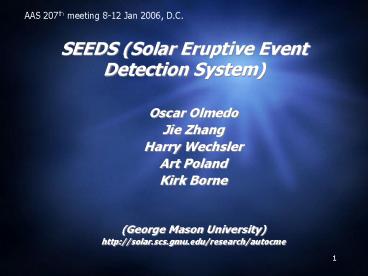SEEDS Solar Eruptive Event Detection System PowerPoint PPT Presentation
Title: SEEDS Solar Eruptive Event Detection System
1
SEEDS (Solar Eruptive Event Detection System)
AAS 207th meeting 8-12 Jan 2006, D.C.
- Oscar Olmedo
- Jie Zhang
- Harry Wechsler
- Art Poland
- Kirk Borne
- (George Mason University)
- http//solar.scs.gmu.edu/research/autocme
2
Objectives
- Develop an automatic system of solar transient
events - Detection (Current Work)
- Classification (Future Work)
- Association (Future Work) i.e. between EIT
Dimming/CME/Flare - An automatic system is needed
- Explosive growth of data (STEREO and SDO)
- Human detection becomes costly or impossible
- Timely detection, for event catalog
- Timely detection, for space weather forecasting
- Objective detection, reducing human bias
- Accurate measurement
- Extracting more parameters
- Classification using high dimensional input data
3
Methodology (For CME Detection)
- Pre-Processing
- Apply filters
- Polar Transformation
- Initial Detection
- Apply x-axis projection to find outstanding
angles - Parameter extraction (position angle, leading
position, mean brightness, etc.) - Tracking and Detection
- Tracking CMEs path
- Calculation of Velocity and Acceleration
- Cataloguing
4
Pre-Processing
- Calibration
- Median and Smoothing filters to reduce noise
- Running Differencing to remove background
- Polar Transformation for easy array manipulation
Running Difference image
After polar Transformation
5
Initial Detection
- Detecting CME area or angles
- 1-D Projection
- Find CME core angles
CME core angles found with thresholding
1-D projection
6
Initial Detection
- Find CME full angles
- Region Growth
- Closing (Dilation Erosion)
- join features with narrow gaps
- Opening (Erosion Dilation)
- remove narrow features
- Find CME Outline with threshold
- segmentation
7
CME Tracking
- Setting tracking box (yellow)
- Project image within found angles onto the
y-axis and find the max peak, when tracking, this
height must be greater than previous height
detection. - Tracking box lower limit defined by finding the
half-max bellow the max peak. Upper limit is the
edge of the field of view.
half-max
Max Peak
half-max
8
CME Trailing
- Setting trailing box (yellow)
- Some filament cores are brighter than the Leading
Edge (LE) - Remove the gusty outflow following a CME
- Some outflow blobs are brighter than the LE
- Initially re-setting all pixels in box to zero
- Gradually return,in time, pixel value to normal
level - FmF0 (1- exp (-(T-T0)/Tm))
- Exponential modulation function is used
- Suppressing blobs
- But revealing a new CME
9
Example Tracking Sequence
10
Example Sequence (Projection of edge onto Helio
image)
11
Statistics
- 2002 Events
- SEEDS --- 253 events
- CACTUS1 --- 409 event
- GSFC/NRL2 --- 162 events
- Assuming GSFC/NRL catalog ground-truth
- SEEDS detects 76.5 (True Positive rate) CMEs
(124/162) - SEEDS misses 23.4 (False Negative rate) CMEs
(38/162) - SEEDS finds 79.6 more events than GSFC/NRL
(129/162)
1 E. Robbrecht D. Berghmans, Automated
recognition of coronal mass ejections (CMEs) in
near-real-time data, AA 425, 1097
(2004) http//sidc.oma.be/cactus/publi/ 2 CME
catalog is generated and maintained at the CDAW
Data Center by NASA and The Catholic University
of America in cooperation with the Naval
Research Laboratory. SOHO is a project of
international cooperation between ESA and
NASA. http//cdaw.gsfc.nasa.gov/CME_list/
12
Statistics
- Bar graphs on this page
13
Statistics
- Scatter plots on this page
14
The Next Stage
- Formalize the C2 detection
- Extend to C3 detection
- Merging C2/C3 data
- Detecting dimming/flaring features in EIT
- Classification using data mining tools
- Association using data mining tools
- automatically identify solar surface source
region of a CME - A full online catalog
15
Discussion and the Future
- Apply the tools with twin SECCHI instruments plus
SOHO LASCO/EIT - Determine the true CME velocity and moving
direction in the inner heliosphere in 3-D - Fully develop the image processing, data mining,
3-D tracking tools for automatic
detection/tracking of solar eruptive events - Need real time tools for space weather forecasting

